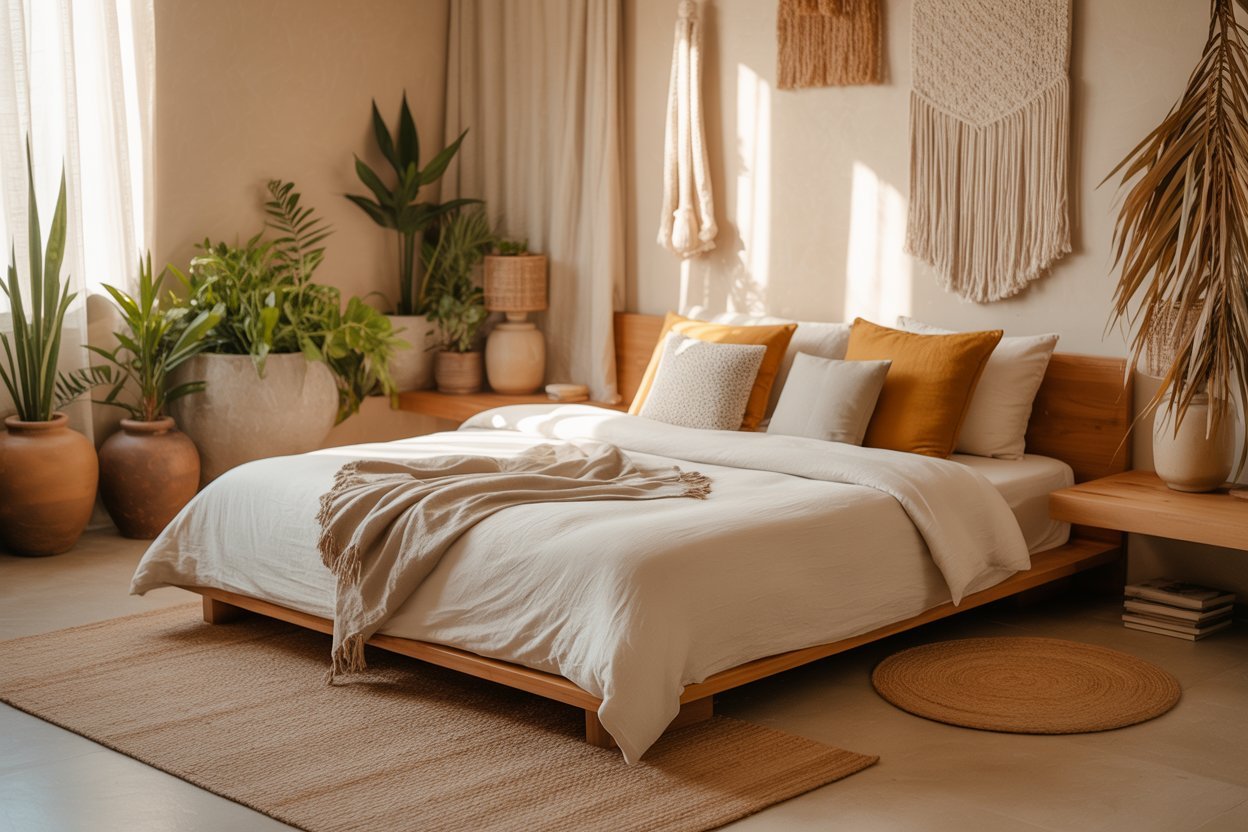
The modern bedroom has evolved beyond mere aesthetics into a psychological refuge where biophilic design principles meet our innate need for grounding. These earthy bedroom ideas tap into what I call “Terrestrial Minimalism”—a design philosophy that acknowledges our subconscious craving for natural elements in spaces where we’re most vulnerable. By integrating organic materials, warm earth tones, and textures reminiscent of nature, these concepts create environments that lower cortisol levels and invite restorative sleep. Each idea serves as a bridge between the built environment and the natural world we instinctively seek.
With Natural Wood Headboards

A reclaimed wood headboard serves as the bedroom’s architectural anchor, providing both visual weight and textural authenticity. These pieces carry stories within their grain patterns and weathered surfaces, establishing what I term “narrative grounding”—the psychological comfort of knowing your space contains elements with history. Choose headboards with visible knots, varied wood tones, and raw edges that haven’t been over-processed. The organic irregularities create visual interest while maintaining a sense of calm. Pair with simple bedding to let the wood’s natural character dominate the space without overwhelming the senses.
Using Terracotta Color Palettes
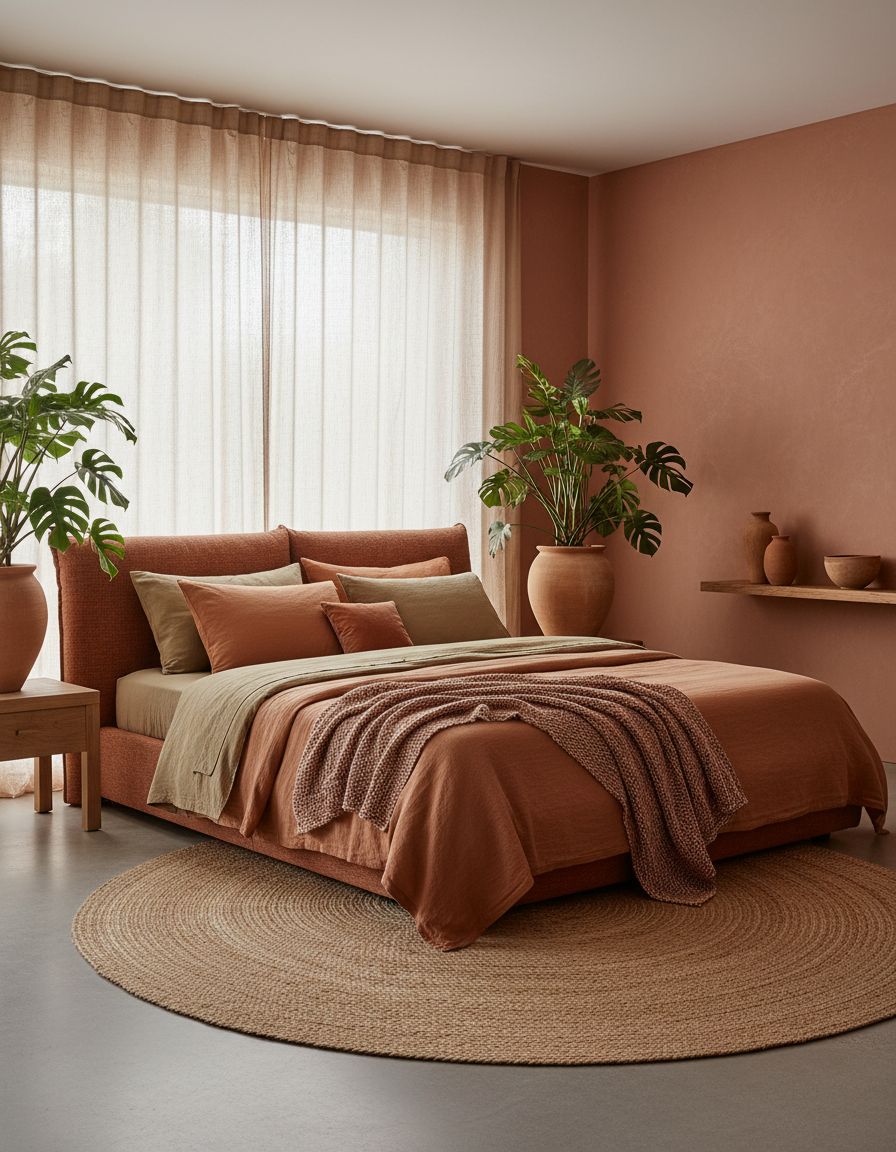
Terracotta hues evoke Mediterranean landscapes and ancient earthenware, triggering subconscious associations with warmth and shelter. This palette ranges from burnt sienna to soft clay, creating what I describe as “chromatic comfort”—colors that feel inherently safe. Incorporate these tones through painted accent walls, textured throw pillows, or ceramic vessels on nightstands. The psychological impact of terracotta is profound; studies suggest warm earth tones reduce anxiety and promote feelings of security. Layer different shades to add depth while maintaining the monochromatic harmony that defines sophisticated earthy bedroom ideas.
Featuring Rattan Furniture
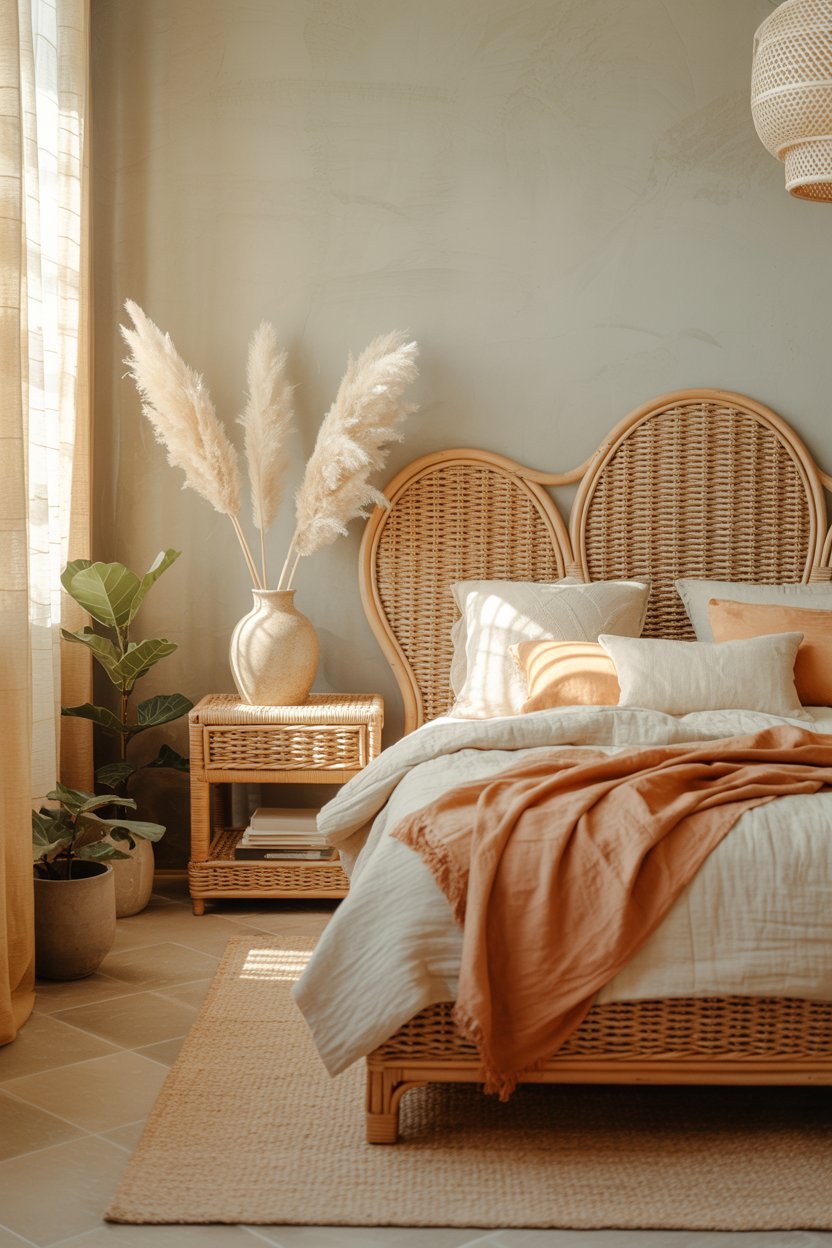
Rattan furniture introduces organic curves and natural texture that soften the hard angles typically found in bedroom architecture. The woven construction creates dimensional shadows that shift with natural light throughout the day, providing subtle visual stimulation without distraction. Consider a rattan bed frame, nightstand, or accent chair to establish what I call “textural rhythm”—the repetition of natural patterns that our eyes find inherently soothing. Rattan’s lightweight appearance prevents the space from feeling heavy despite its substantial presence, making it ideal for earthy bedroom ideas in smaller spaces seeking organic warmth.
With Stone Accent Walls
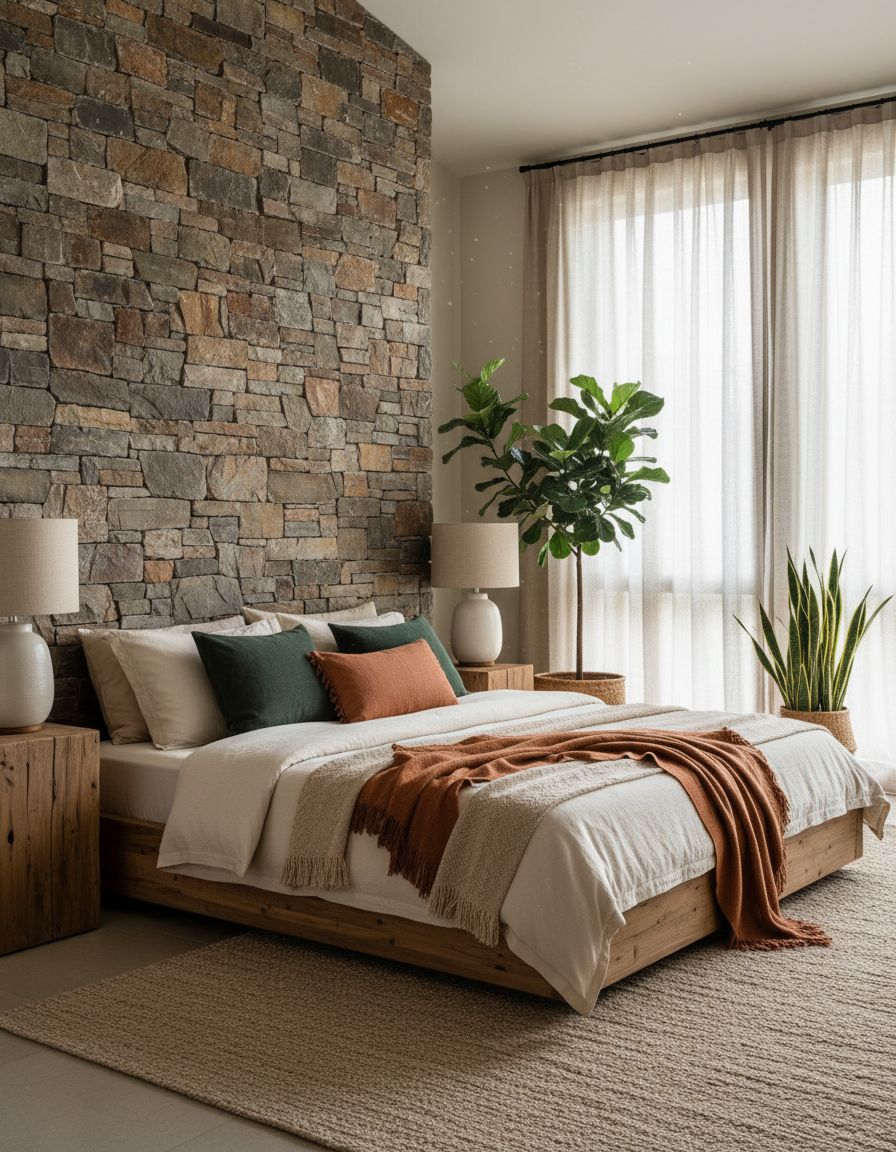
A stone accent wall transforms a bedroom into a grounded sanctuary by literally bringing geological elements indoors. Whether using stacked slate, river rock, or limestone panels, the varied surface creates tactile interest that flat walls cannot achieve. This design choice taps into our evolutionary preference for cave-like sleeping quarters—spaces that feel protected and secure. The thermal mass of stone also provides subtle temperature regulation, contributing to physical comfort beyond aesthetics. Focus the stone wall behind the bed to create a natural focal point that grounds these earthy bedroom ideas in primordial comfort.
Incorporating Organic Linen Bedding
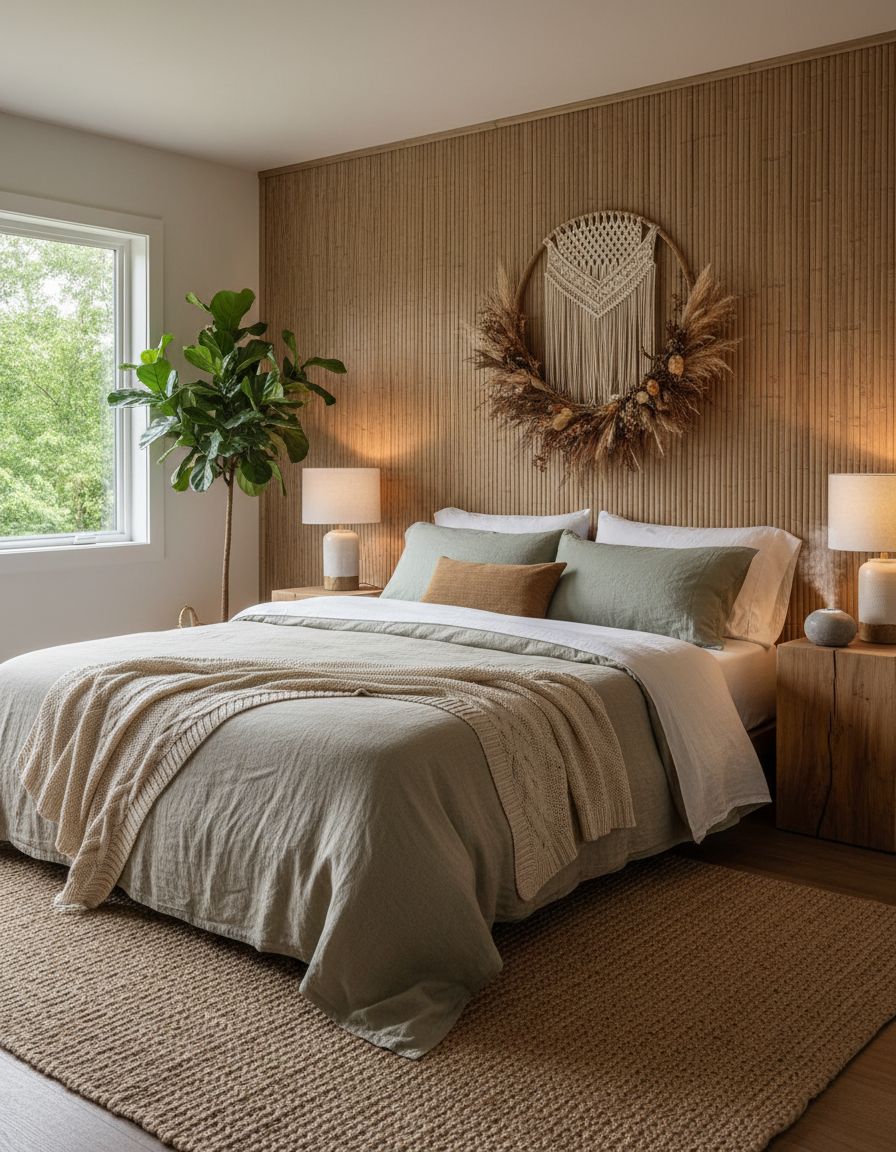
Organic linen bedding represents the intersection of sustainability and sensory pleasure, offering a slightly textured surface that improves with age and washing. Unlike synthetic materials, linen breathes naturally and regulates temperature, creating what I term “adaptive comfort”—bedding that responds to your body’s needs throughout sleep cycles. Choose undyed or naturally dyed linens in oatmeal, sand, or soft gray to maintain earthy authenticity. The subtle imperfections and natural slubs in linen weave add visual character while maintaining the relaxed, unpretentious aesthetic central to successful earthy bedroom ideas that prioritize substance over superficial perfection.
With Jute and Sisal Rugs

Natural fiber rugs ground the bedroom literally and figuratively, providing textural contrast to smooth flooring while absorbing sound for a quieter sleep environment. Jute and sisal offer durability alongside their organic aesthetic, aging gracefully rather than deteriorating. The neutral tones of these materials serve as a foundation that allows other design elements to shine without competing for attention. I refer to this as “foundational neutrality”—design elements that support without dominating. Layer a jute rug with a softer sheepskin or wool accent to add dimensional comfort while maintaining the natural material palette essential to cohesive earthy bedroom ideas.
Using Clay and Ochre Tones

Clay and ochre tones reference the earth’s pigmented soils, creating an instinctive sense of being grounded and sheltered. These warm, muted colors have been used in human dwellings for millennia, triggering ancestral comfort responses in our subconscious. Implement these hues through wall paint, textiles, or pottery to establish what I call “chromatic continuity”—a color story that flows seamlessly without jarring transitions. The subtle variations within the clay-ochre spectrum prevent monotony while maintaining visual coherence. These earthy bedroom ideas particularly benefit from natural light, which reveals the complex undertones throughout the day.
With Live Edge Wood Accents
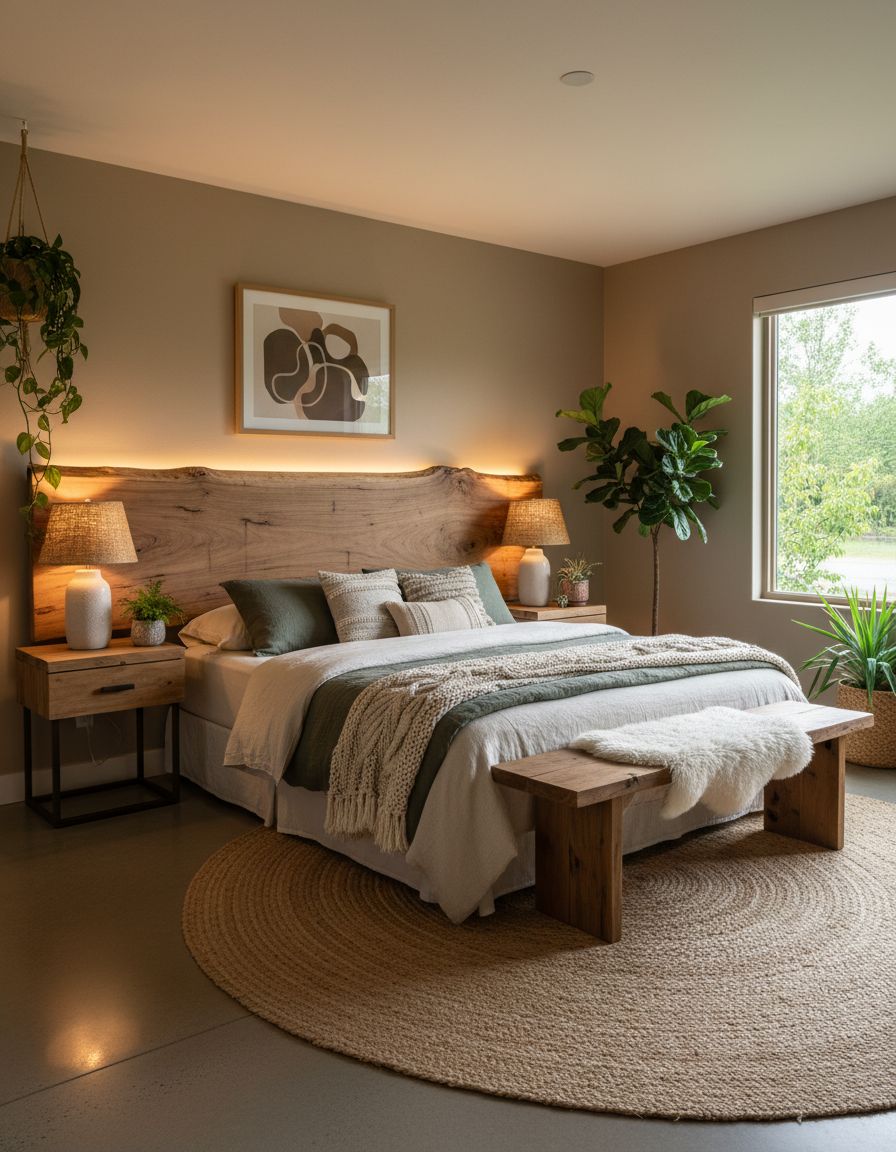
Live edge wood preserves the tree’s natural contour, bringing organic irregularity into spaces typically dominated by manufactured right angles. Whether as a bench, shelf, or bedside table, these pieces celebrate imperfection and natural growth patterns. This design choice creates what I describe as “deliberate imperfection”—the intentional inclusion of organic variation that makes spaces feel more human and less sterile. The unique character of each live edge piece ensures your bedroom remains distinctive while adhering to earthy aesthetic principles. Pair with simple, clean-lined furniture to let the live edge element command attention appropriately.
Featuring Woven Wall Hangings
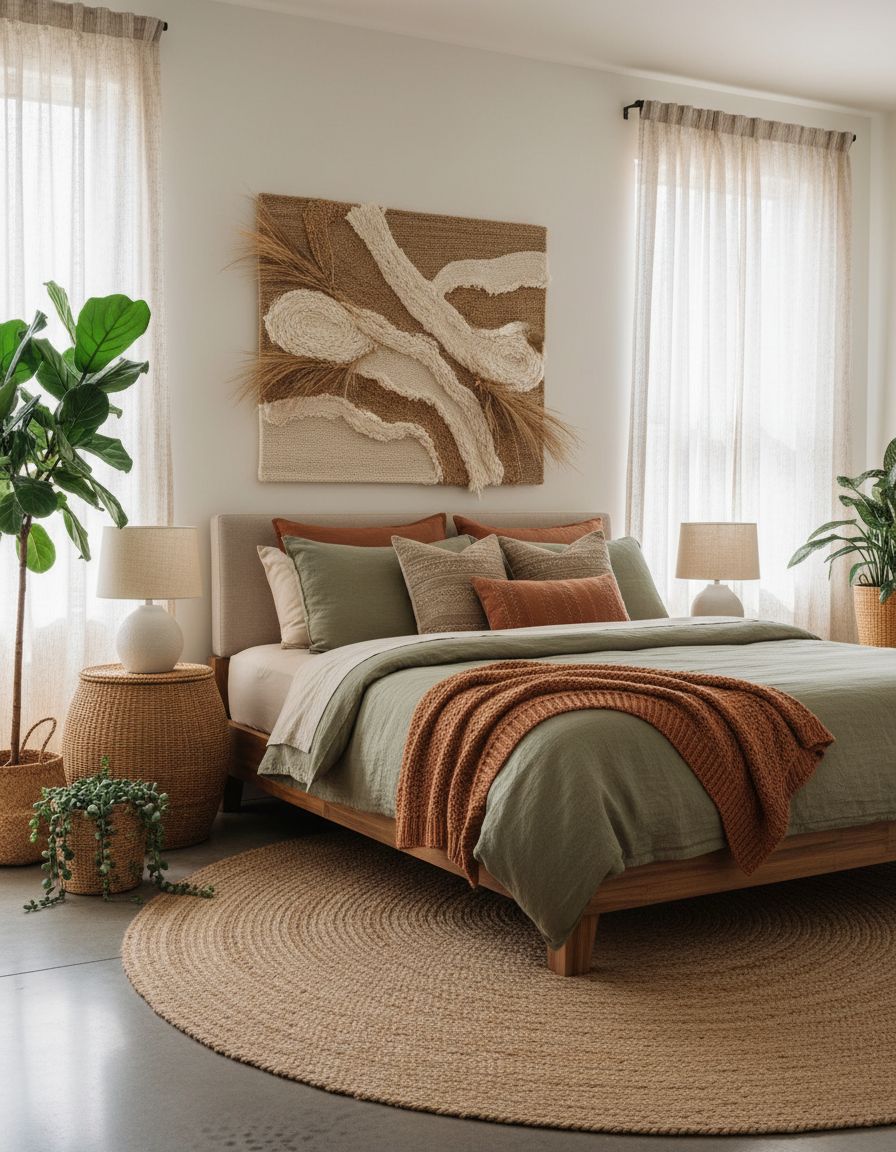
Textile wall art introduces softness and handcrafted authenticity to bedroom walls, creating visual warmth that framed prints cannot replicate. Woven pieces in natural fibers like wool, cotton, or jute add dimensional texture while absorbing sound for improved acoustic comfort. The handmade quality of these hangings contributes to what I term “artisanal intimacy”—the feeling that your space contains objects made with human care and skill. Choose pieces in neutral tones with subtle pattern variations to maintain the understated elegance central to sophisticated earthy bedroom ideas that avoid trending toward bohemian excess.
Using Natural Fiber Lampshades

Lighting filtered through woven grass, rattan, or linen lampshades creates a warm, diffused glow that mimics natural light patterns through tree canopies. This subtle illumination supports circadian rhythms better than harsh overhead lighting, contributing to improved sleep quality. The organic materials add textural interest while serving functional purposes—a design principle I call “beautiful utility.” Natural fiber shades work particularly well with warm-toned bulbs that enhance the earthy color palette throughout the room. Consider multiple lighting sources at different heights to create layered, adjustable ambiance essential to versatile earthy bedroom ideas.
With Reclaimed Wood Flooring

Reclaimed wood flooring carries history in every plank, providing character-rich surfaces that new materials cannot replicate. The varied patina, nail holes, and weathering tell stories while delivering exceptional durability. This choice exemplifies what I call “sustainable narrative”—design decisions that honor environmental responsibility while adding aesthetic value. The warmth underfoot and natural color variations create a foundation that anchors all other design elements. Seal with natural oils rather than synthetic finishes to maintain the wood’s breathing capacity and authentic texture, keeping these earthy bedroom ideas genuinely connected to their material origins.
Incorporating Dried Botanical Displays
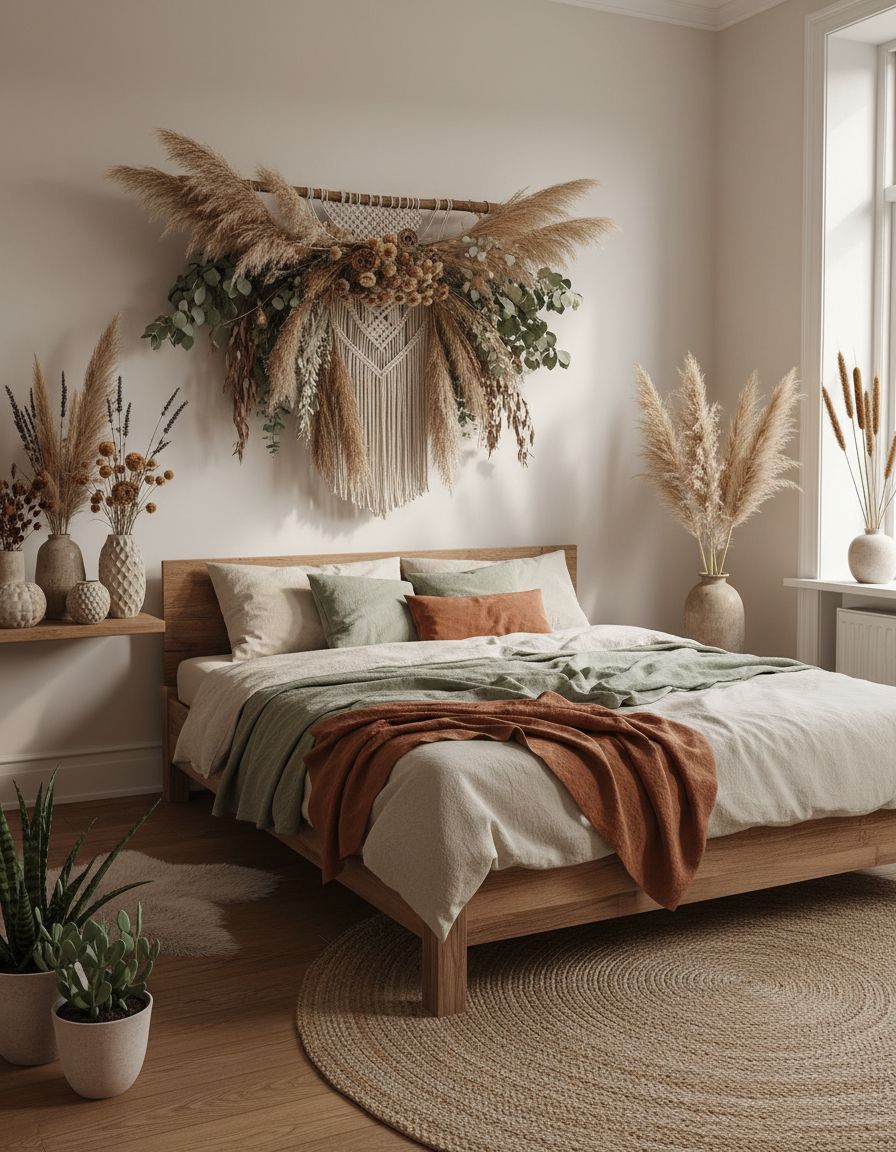
Preserved grasses, seed pods, and branches bring organic forms indoors without the maintenance requirements of living plants. These sculptural elements create what I describe as “static nature”—the visual presence of the natural world frozen at peak beauty. Arrange dried botanicals in simple ceramic vessels or display striking branches alone as minimalist statements. The neutral tones of dried materials integrate seamlessly with earthy color palettes while adding vertical interest and delicate texture. Unlike artificial plants, preserved botanicals maintain authentic imperfection and gradual transformation, acknowledging the natural cycle of growth and decay.
Using Bamboo Design Elements

Bamboo’s rapid renewability and natural strength make it both an environmentally conscious choice and a visually appealing material. Whether as window treatments, furniture, or decorative accents, bamboo introduces linear texture and warm honey tones. The material’s association with Eastern design philosophy adds a contemplative quality to bedrooms, promoting what I term “material mindfulness”—heightened awareness of sustainable choices. Bamboo’s natural antibacterial properties also contribute to healthier indoor air quality. Incorporate through Roman shades, a ladder shelf, or picture frames to weave this versatile material throughout your earthy bedroom ideas cohesively.
With Cork Wall Treatments

Cork wall panels or tiles provide exceptional acoustic dampening while adding subtle texture and warmth to bedroom walls. This sustainable material harvested from tree bark without harming the tree exemplifies environmental responsibility meeting functional design. Cork’s natural insulation properties help regulate temperature, creating physical comfort alongside visual appeal—what I call “performance aesthetics.” The material’s varied grain patterns add organic interest without overwhelming, and its neutral tone serves as an excellent backdrop for artwork or minimalist styling. Cork walls particularly benefit earthy bedroom ideas in urban settings where noise reduction enhances sleep quality significantly.
Featuring Warm Neutral Layers

Layering cream, taupe, sand, and mushroom tones creates dimensional depth without relying on bold color contrasts. This approach builds what I describe as “tonal sophistication”—visual interest achieved through subtle variation rather than dramatic statements. Mix materials with similar colors but different textures: smooth cotton sheets, nubby linen throws, and soft wool pillows. The monochromatic restraint allows natural materials and textures to take center stage. This layering technique proves especially effective in smaller bedrooms where too much color variety can feel chaotic, making these earthy bedroom ideas both calming and spatially flexible.
Using Handcrafted Ceramic Decor
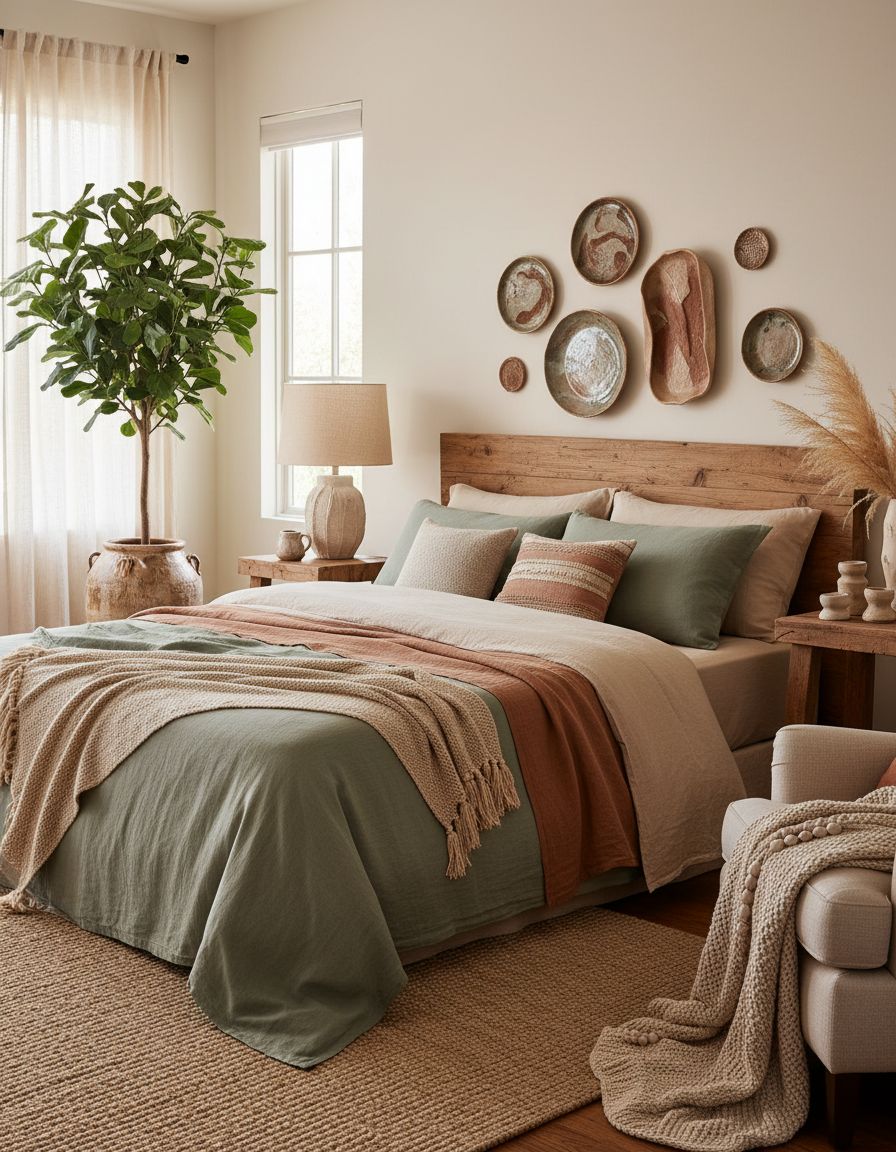
Artisan ceramics bring human touch and earth’s raw materials into the bedroom through functional vessels and decorative objects. The slight irregularities in handthrown pottery create what I call “touched beauty”—items that reveal their maker’s hand and resist mass-produced uniformity. Choose pieces in natural clay tones, perhaps with subtle reactive glazes that mimic geological processes. Display as vases, planters, or sculptural objects on nightstands and shelves. The weight and coolness of ceramic provides sensory contrast to soft textiles, creating balanced earthy bedroom ideas that engage multiple senses beyond sight alone.
With Natural Stone Flooring
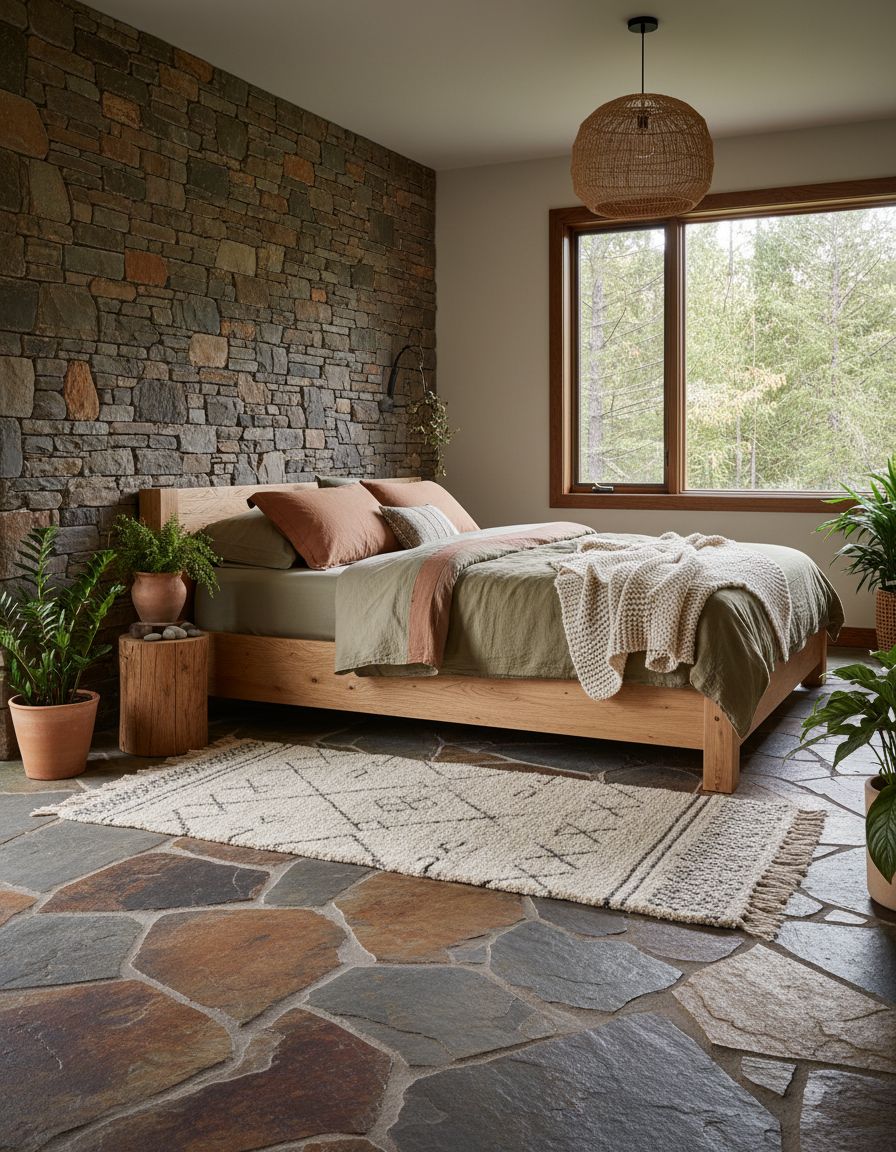
Stone flooring in materials like travertine, slate, or limestone brings geological permanence into the bedroom, creating a foundation of enduring beauty. The cool surface provides temperature regulation in warmer climates while adding textural variation underfoot. This choice represents what I term “elemental grounding”—the incorporation of materials formed over millennia that put daily concerns into perspective. The natural variation in stone patterning ensures no two installations are identical, maintaining individuality while adhering to earthy aesthetic principles. Pair with radiant heating for year-round comfort, and add natural fiber rugs for softness where you step out of bed.
Incorporating Macramé Details
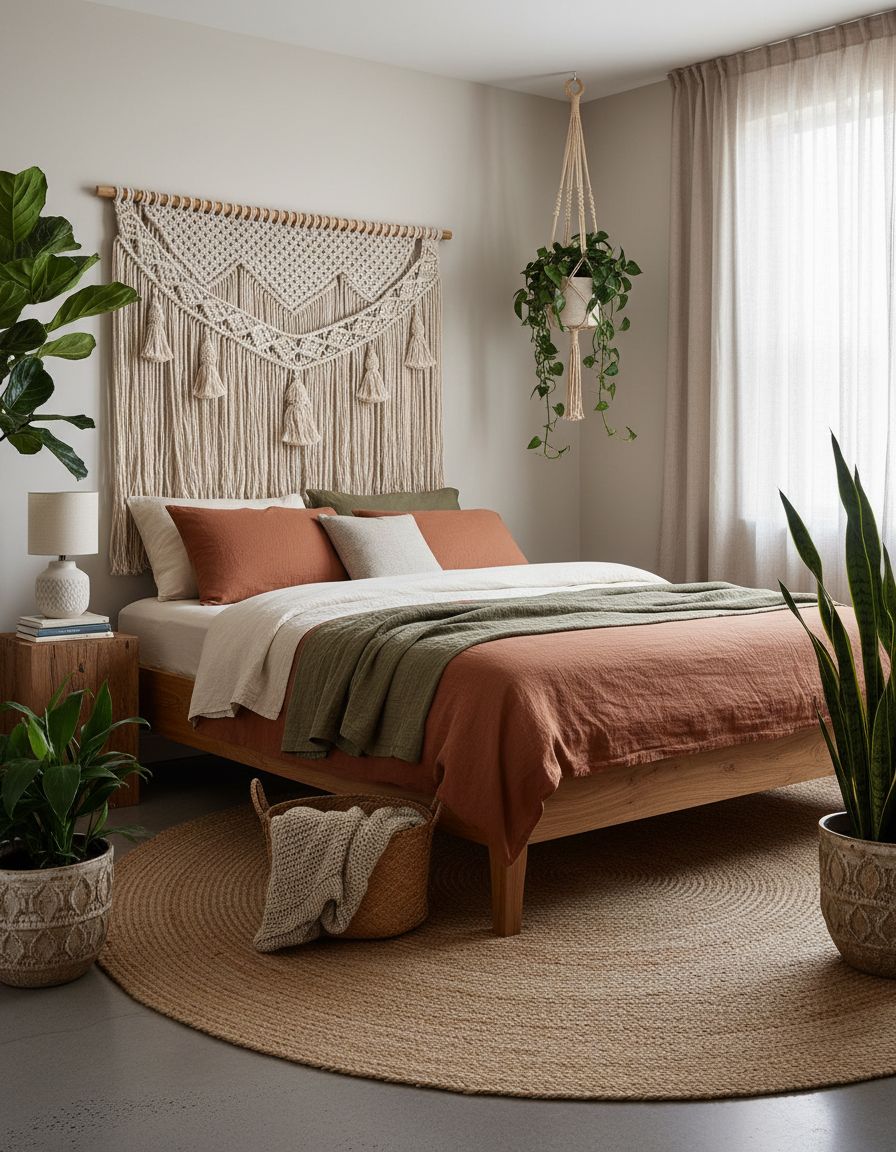
Macramé’s knotted construction adds dimensional texture through shadows and geometric patterns created by natural cotton rope. Whether as wall hangings, plant holders, or headboard accents, this handcraft technique introduces what I describe as “meditative texture”—patterns created through repetitive, mindful action. The neutral tones of natural cotton fiber integrate seamlessly with earthy palettes while adding bohemian warmth without excess. Macramé’s current resurgence reflects our collective desire for handmade elements that counter digital life’s intangibility. Choose pieces with clean, modern patterns to keep earthy bedroom ideas contemporary rather than dated or overly nostalgic.
Using Sage and Moss Greens
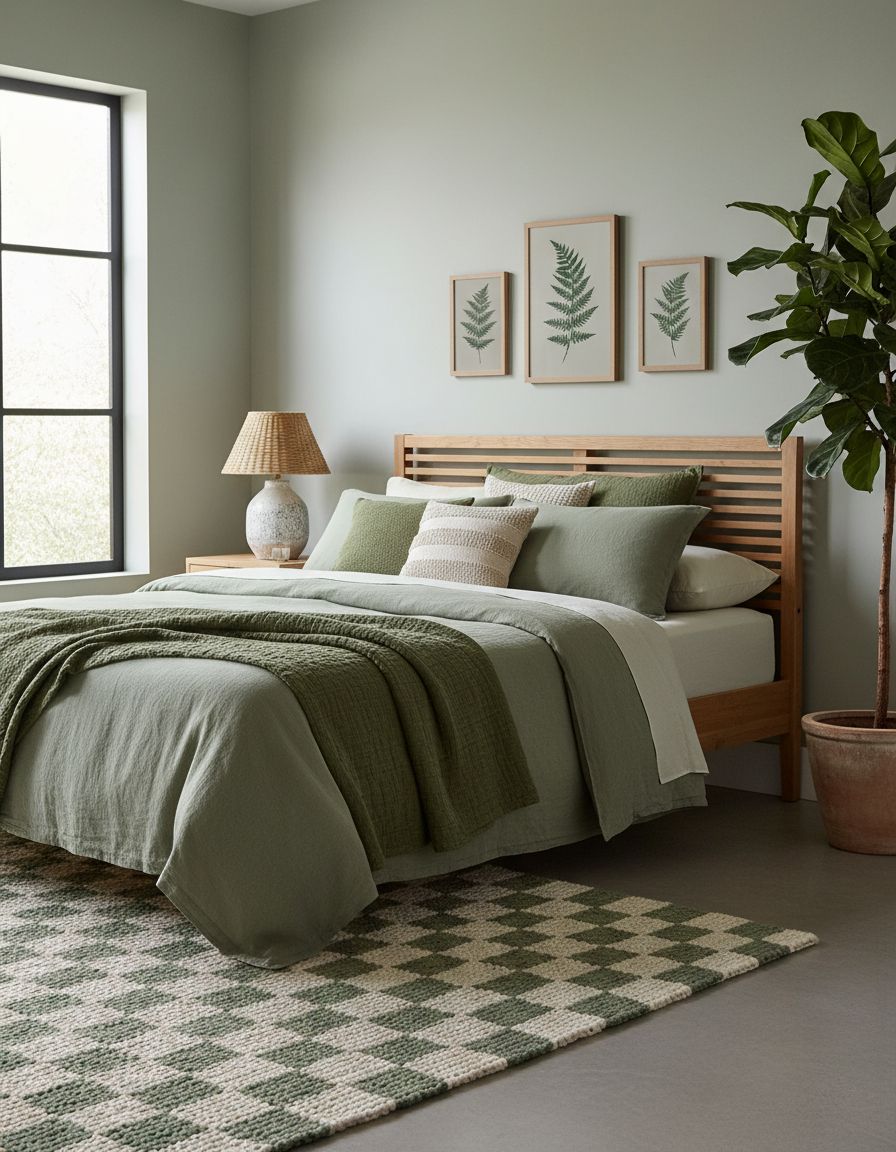
Muted botanical greens bring the outdoors inside through color rather than literal plant life, creating restorative environments backed by color psychology research. These hues trigger the parasympathetic nervous system, promoting relaxation essential for quality sleep—what I call “chromatic restoration.” Sage and moss tones pair beautifully with warm wood, terracotta, and neutral textiles, grounding earthy bedroom ideas in nature’s palette. Apply through painted walls, bedding, or upholstered furniture depending on your commitment level. The understated sophistication of these greens avoids the sterility of cool grays while maintaining the calm essential to bedroom sanctuaries.
With Wicker Storage Baskets
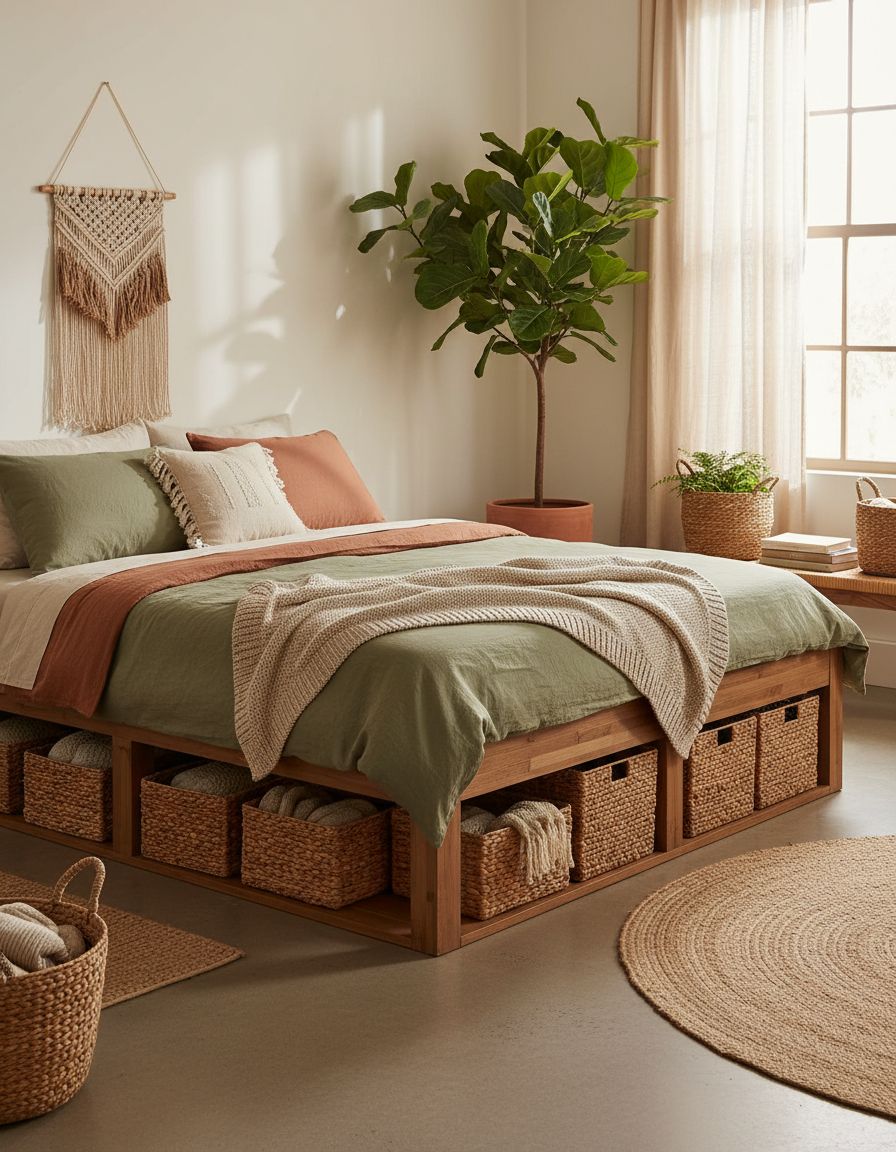
Woven storage solutions combine functionality with organic texture, concealing clutter while maintaining the natural material aesthetic. Baskets in varied sizes create what I term “organized naturalism”—practical storage that contributes to rather than detracts from design intentions. The handwoven construction adds artisanal character while providing breathable storage for linens, blankets, and personal items. Choose baskets in natural tones without synthetic dyes or treatments to maintain authentic earthy bedroom ideas. Stack on open shelving, tuck under benches, or display individually to add dimensional interest while solving the universal challenge of bedroom storage needs.
Featuring Raw Plaster Walls

Unfinished or minimally finished plaster walls offer subtle texture variations and organic imperfection that perfectly embody earthy design philosophy. The matte surface absorbs light rather than reflecting it, creating the soft, diffused atmosphere conducive to relaxation. This treatment represents what I describe as “humble elegance”—beauty found in restraint and natural materials rather than elaborate finishes. The slight color variations and application marks add character while maintaining simplicity. Raw plaster works particularly well in modern earthy bedroom ideas, where the contrast between minimalist furniture and textured walls creates sophisticated tension without busyness.
Using Chunky Knit Textiles
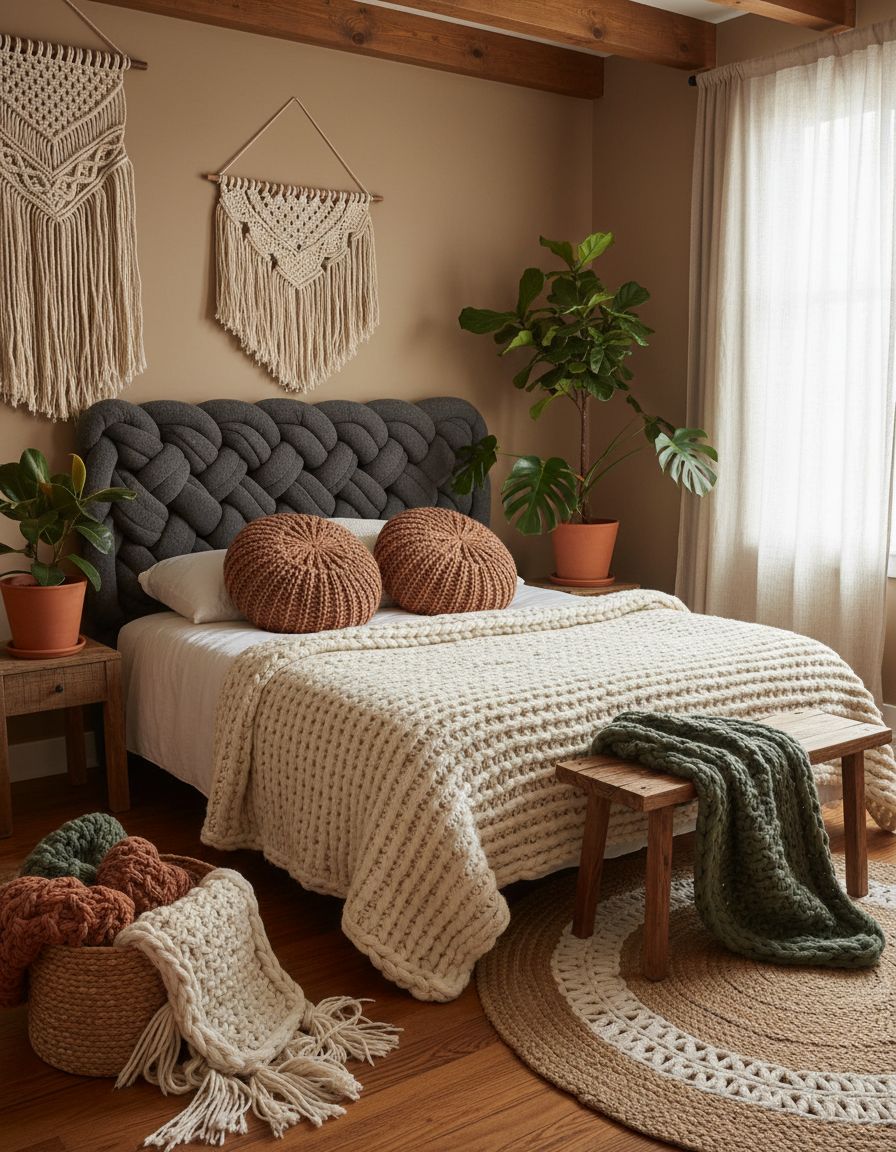
Oversized knit blankets and pillows provide tactile comfort while adding dimensional texture that flat textiles cannot achieve. The chunky gauge creates visual weight and cozy appeal—what I call “embraceable texture”—inviting physical interaction and comfort. Choose natural fibers like wool or organic cotton to maintain material authenticity central to earthy design principles. The sculptural quality of thick knits adds organic irregularity that prevents bedrooms from feeling too controlled or sterile. Layer across the bed or drape over seating to introduce softness and warmth, particularly effective in earthy bedroom ideas within modern or minimalist architectural contexts.
With Indoor Plant Sanctuaries
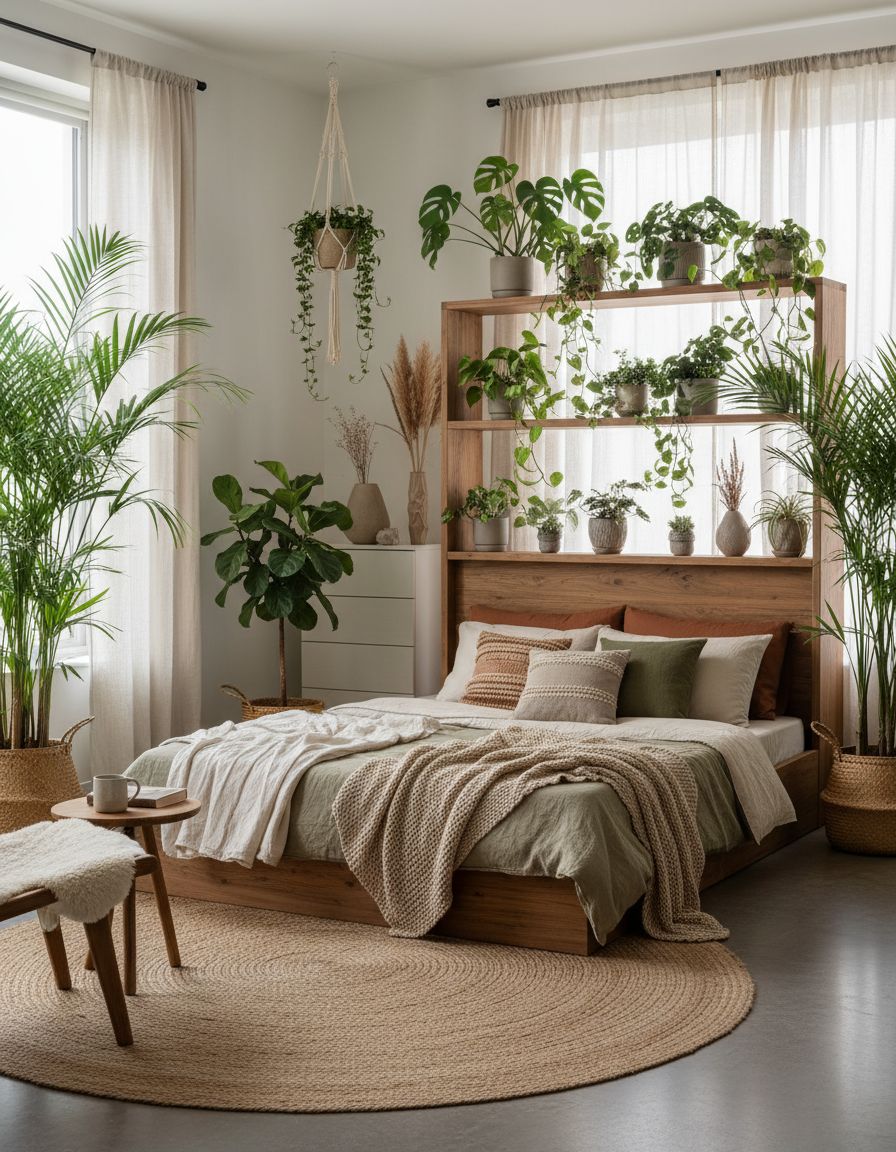
Transforming bedrooms into plant-filled retreats creates living, breathing environments that literally improve air quality while providing psychological benefits. Multiple plants at varying heights establish what I term “layered vitality”—the dynamic presence of growing things that evolve with seasons and care. Choose varieties suited to bedroom light conditions, prioritizing those with air-purifying qualities like snake plants or pothos. The care routine itself becomes a mindfulness practice, deepening your connection to the space. These earthy bedroom ideas particularly benefit those seeking biophilic design’s full potential, where nature isn’t referenced but actively present.






